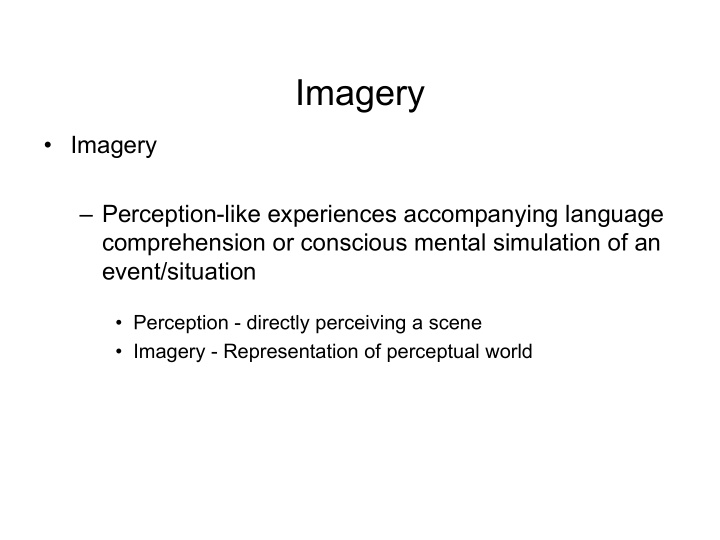



Imagery • Imagery – Perception-like experiences accompanying language comprehension or conscious mental simulation of an event/situation • Perception - directly perceiving a scene • Imagery - Representation of perceptual world
Imagery • Is imagistic representation analog or propositional? – Analog - imagistic representations are similar to perceptual representations – Propositional - imagistic representations are not visual or spatial. Perceptual relationships do not directly carry over to mental representations.
Imagery • Analog representation • Iconic – Buzz , gulp , meow vs. Bee, drink, cat • Continuous – Analog vs. digital clock – Conventional vs. digital thermometer • Map or picture like – Graphs, charts, diagrams vs. prose • Image can be manipulated like physical object it represents
Imagery A D B C
Imagery
Imagery • Propositional representation – Descriptive • ‘Go Right’ vs. -----> – Discrete • Parameters and values – Symbolic
Imagery A. The lamp is above the table B. The table is under the lamp B follows from A Analog - comprehension of relationship is due to relationship between image and real world Propositional - relationship between above and under is learned and stored and can be called upon without using imagery
Imagery Monk Problem: A Buddhist monk begins at dawn one day walking up a mountain, reaches the top at sunset, meditates at the top for several days until one dawn when he begins to walk back to the foot of the mountain, which he reaches at sunset. Making no assumptions about his starting or stopping or about his pace during the trips, prove that there is a place on the path which he occupies at the same hour of the day on the two separate journeys. (Koestler 1964):
Imagery
Imagery • Evidence for analog representation would be evidence that imagery is used in ways similar to direct perceptual experience, i.e. imagery influences thought processes like perception. • Evidence for propositional representation would be evidence that imagery does not provide information similar to direct perception.
Imagery • Sheperd & Metzler study – Mental rotation • Kosslyn studies – Image & size • Imagine an elephant standing next to a rabbit – Boat picture • Decision times on boat questions longer if preceding question pertained to more distant part of boat – Campus map • Decisions times on landmark distances correlated with actual distances
Imagery • Neuropsycholgy – Kosslyn – monk studies • Same parts of brain active during direct viewing and during imagery – Ingvar – blood flow study • Visualizing taking a walk produced blood flow in same regions as during visual processing – Davidson & schwartz – alpha wave suppression • Occipital alphas suppressed during visual processing and imaging • Parietal alpha suppressed during touch processing and imaging
Imagery • Evidence against analog representation (Plyshyn) - Imagine rotating a cube so that 1 corner is directly over another. How will remaining Corners be arranged in space?
Imagery Remaining corners are not in a single horizontal plane.
Imagery McCloskey - folk models of physics Subjects imagine false trajectories for ball.
Imagery • Propositional and analog – Imagery part of propositional knowledge
Imagery • Talmy- levels of reality/palpability of ception Concrete --> semiabstract --> abstract --> fully abstract • Concrete - – Normal perception (any modality) • Semi-abstract – Perceivable but lacking palpability, vividness, detail, etc.
Imagery • Hermann Grid
Imagery Stare at the image
Imagery • Stare at the image
Imagery • Abstract level – Schematic representations of structure • Object structure • Path structure • Structural history • Projected paths
Imagery • Object structure – Structural pattern – Magnitude neutral – Shape neutral • Envelope/interior (container) – Thimble/punchbowl/volcano
Imagery • Object structure – Structural pattern for arrays of objects • Container/contained • “inside” relationship
Imagery • Path structure – Schema for path • Ex. Across, through, into – Magnitude neutral • Deer ran across forest • Ant crawled across hand – Shape neutral • zigzag/straight line path
Imagery • Structural history – Imagined history of configuration • Pac-man = circle with wedge removed
Imagery • Irregular contour = regular shape with outpouchings and indentations Oval or rectangle +/- some angles, points, protuberances, etc.
Imagery • Picture frame on wall as tilted from canonical position
Imagery • Scatter (cf. Advent path) – Pottery shards as remains of a pot – Toys/anthills located randomly through space » Scatter path sensed
Imagery • Projected paths – Object in motion generates path that is sensed not seen (trajectory) – Generated routes • Traffic • lines
Imagery – Fully abstract • No concurrent on-line sensory stimulation • “many cognitive entities at the abstract level of palpability are the semantic referents of linguistic forms and thus can also be evoked in awareness by hearing or thinking of those forms.”
Recommend
More recommend